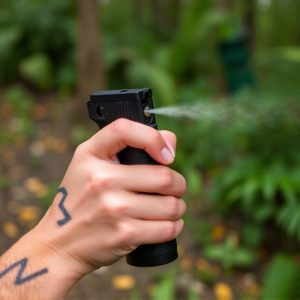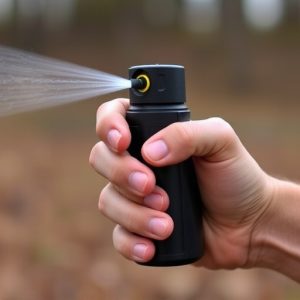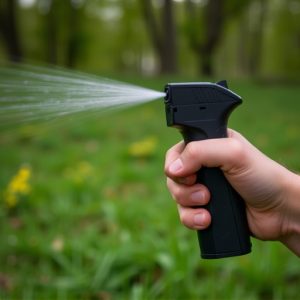Choosing Safe and Legal Alternative Weapons for Effective Self-Defense
This discussion compares alternative weapons such as pepper spray and stun guns to traditional fire…….
This discussion compares alternative weapons such as pepper spray and stun guns to traditional firearms for personal defense, particularly in places with stringent gun laws or high accidental harm risks. Both pepper spray and stun guns are legal in many areas where guns are not, offering a balance between effectiveness and safety. Pepper spray is user-friendly and can be deployed from a distance, while stun guns provide close-range defense. Personal alarm systems also serve as effective deterrents by emitting loud sirens to draw attention and potentially fend off attacks. The importance of understanding and complying with local self-defense laws cannot be overstated. Additionally, self-defense training is highlighted as a key proactive measure for personal protection, enhancing confidence and awareness. The choice of an alternative weapon should be informed by legal restrictions, personal preference, and specific situations one might encounter, as each has its unique advantages and considerations in the context of non-lethal self-defense strategies. Users are encouraged to select a tool that suits their circumstances and to become proficient in its use within the confines of the law for effective personal protection.
In today’s world, personal safety remains a paramount concern for many. For those seeking alternatives to traditional firearms for self-defense, a variety of non-lethal options exist. This article delves into the realm of safe and legal alternative weapons, evaluating their pros and cons to guide your choice in personal protection tools. From pocket-sized devices to more robust deterrents, we provide a comprehensive guide to selecting the most suitable non-lethal self-defense weapon for your needs, ensuring you are informed and prepared without compromising on safety or legality. Understanding the landscape of available options is key to making an empowered decision in safeguarding yourself and your loved ones.
Exploring Safe and Legal Alternative Weapons to Guns for Self-Defense
When considering self-defense, it’s crucial to weigh the options beyond traditional firearms, especially in regions with stringent gun laws or where the risk of accidental harm is high. Pepper spray and stun guns are two alternative weapons to guns that offer a balance between effectiveness and safety. These devices can be highly effective in deterring attackers by incapacitating them through inflammation-inducing agents or an electrified shock, respectively. Pepper sprays are easy to carry and deploy, with a range that allows users to maintain a safe distance from potential threats. Stun guns, while also non-lethal, provide a contact option that can be disarming in close encounters. Both options are legal in many jurisdictions where firearms may not be permitted or are restricted. It’s important for individuals to familiarize themselves with local laws and regulations regarding self-defense tools to ensure they are both safe and compliant with the law. Additionally, personal alarm systems can also serve as a deterrent, alerting bystanders and authorities to your distress, potentially preventing an attack before it escalates. These alternative weapons, when used responsibly and in accordance with local laws, can be valuable additions to one’s self-defense strategy.
The Pros and Cons of Common Alternative Weapons for Personal Protection
When considering personal protection beyond conventional firearms, a variety of alternative weapons offer different advantages and drawbacks. Pepper spray, for instance, is a non-lethal option that can effectively incapacitate an attacker with its intense irritant effects. Its ease of use and portability make it a popular choice among individuals seeking a quick and accessible means of self-defense. However, its effectiveness can be mitigated by wind conditions or if the assailant is wearing protective gear. Similarly, stun guns and Tasers deliver a high-voltage shock to temporarily disable an attacker. These devices are highly effective under ideal conditions but may not work on individuals who are significantly larger or on those who are unaffected by electrical shocks for medical reasons. Stun weapons should be used with caution as local laws dictate their legality and the circumstances under which they can be deployed.
On the other hand, personal alarms serve as a deterrent rather than a direct defense mechanism. Their loud, attention-grabbing sound can alert bystanders to your predicament and potentially scare off an attacker. They are legal in most jurisdictions and require no training to operate. Yet, their effectiveness relies on the proximity to people who will respond to the alarm, making them less reliable in isolated areas. Additionally, self-defense training is a non-weapon alternative that empowers individuals with the skills to avoid confrontations or defend themselves in a variety of situations. While it doesn’t replace the immediate deterrence of a weapon, it offers a proactive approach to personal protection by building confidence and awareness. Training requires commitment but can be a lifelong asset for safety. Each of these alternatives to guns has its place in the spectrum of self-defense options, and the choice often depends on individual circumstances, legal considerations, and personal comfort levels with each method.
A Comprehensive Guide to Selecting the Most Suitable Non-Lethal Self-Defense Tool
When considering self-defense options, non-lethal tools often serve as a prudent alternative to firearms. These weapons are designed to incapacitate an attacker while minimizing the risk of causing serious harm. Selecting the most suitable non-lethal self-defense tool requires an understanding of various factors including legal restrictions, personal proficiency, and situational context. Pepper spray, for instance, is a widely recognized deterrent due to its effectiveness in deterring attackers by inducing temporary blindness and difficulty breathing. It’s compact, easy to carry, and legal in many jurisdictions, making it a popular choice for those looking for a quick-access defense mechanism.
Another option to consider is stun guns or Tasers, which deliver an electrical shock that overpowers the attacker’s motor skills, causing confusion and disorientation without lethal intent. These devices vary in form from handheld models to devices integrated into flashlights, allowing for versatility in personal defense strategies. It’s crucial to familiarize oneself with the operation and proper use of such devices, as well as to comply with local laws regarding their possession and use. Additionally, personal alarm systems can be a deterrent, emitting a loud sound that draws attention to your predicament and deters potential attackers. The choice between these alternative weapons to guns should be informed by a careful assessment of personal needs, comfort levels, and legal considerations. Always prioritize understanding the laws in your area and practicing with your chosen tool to ensure you are prepared to use it effectively should the need arise.


